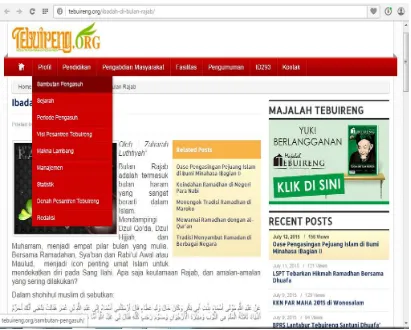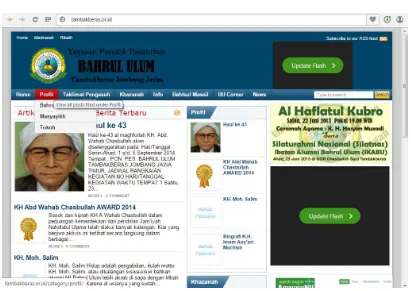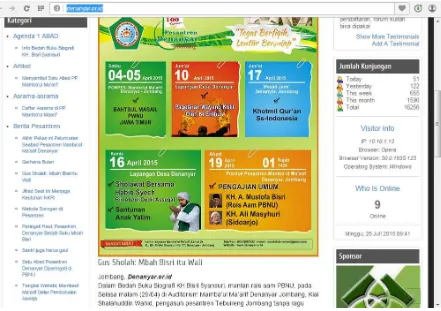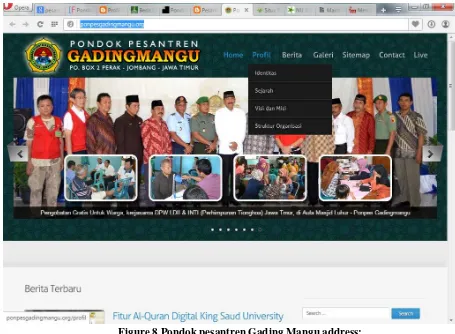EMPOWERMENT ANALYSIS OF THE ONLINE MEDIA USAGE AS AN ISLAMIC INFORMATION PATRON OF PESANTREN INSTITUTIONS IN JOMBANG
Mahrus Ali
Lecturer of the Faculty of Information Technology of Hasyim Asy’ari University Tebuireng Jombang
macus.alay@gmail.com
Abstrak
Ditahun 2015 ini teknologi informasi sangat mengalami perkembangan yang pesat baik teknologi website maupun aplikasi media social yang dijalankan melaui handphone dan
komputer, seperti android yang sudah mewabah pada ponsel dengan harga yang sangat terjangkau. Akan tetapi dengan seiringnya perkembangan teknologi Informasi sampai pada tahun ini, apakah diiringi juga dengan kondisi ilmu pengetahuan dan teknologi yang memadai?, dan apakah juga di iringi dengan kondisi psikologis masyarakat yang stabil di segala usia untuk mengkonsumsi teknologi informasi?. Khususnya pada konsumer teknologi diusia remaja yang mengalami kondisi psikologis yang mengalami fluktuatif dan rasa ingin tahu yang lebih, khususnya remaja muslim yang berdomisili dipesantren.
Namun data yang dihimpun oleh We Are Social, adalah sebuah agensi marketing sosial, mengeluarkan laporan tahunan mengenai data jumlah pengguna website, mobile, dan media sosial dari seluruh dunia. 72,7 juta pengguna aktif internet 72 juta pengguna aktif media sosial, 62 penggunanya mengakses media sosial menggunakan perangkat mobile, 308,2 juta pengguna handphone. Namun lembaga masyarakat yang berbau islami, sudah menerapkan kajian islam baik lewat media social maupun website lembaga tersebut, akan tetapi yang disayangkan, kementerian Komunikasi dan Informasi pernah membuat kebijakan menghapus 22 situs islam yang ada di Indonesia, dengan alasan website tersebut telah menjadi provokator untuk menjadi teroris atau islam radikal. Oleh Karena itu apakah lembaga pesantren sudah mengikuti perkembangan teknologi Informasi dalam mewadahi kajian Islami sesuai dengan undang-undang ITE yang ada di Indonesia?. Akan tetapi dari data peneliti saat ini lembaga pesantren di jombang belum optimal menggunakan Teknologi Informasi sebagai wadah untuk menginformasikan atau membuat kajian islam online.
Kata Kunci : Media online, Informasi, Pesantren
Introduction
In 2015, the world of information technology develops so fast, like website or social media application that is carried out through mobile phone and computer, such android which has been booming in the cell phone with its very reachable price. But, Akan in line with the development of information technology till this year, Is it followed by the sufficient condition of knowledge and technology? Is it also followed by the stable psychological condition of society in every range of ages to consume the information technology? Especially for technology consumers who are teenagers that still have fluctuating psychological condition and deep curiosity, and Moslem teenagers who live in Pesantren.
Figure 1 Total media percentages used for internet access [1]
The most interesting one, there is also a fact that can be caught by the research of APJII and PusKaKom UI. In gender category, in 2014, the internet users in Indonesia are dominated by women. As noted, the women users are almost 51% compared with men, who are only 49 %.[3] Let see the figure below to know the detail:
Figure 2 the total of percentages of internet and social media users[1]
On April 2015, the Ministry of Communication and Information makes a policy to deactivate 22 Islamic sites because they are suspected as terrorism and radicalism provocators. According to the Ministry of Communication and Information, those 22 sites breaks the ITE law about ethics on the usage of information technology. Therefore, by those phenomenon, does Pesantren institutions in Indonesia also proclaim the Islamic information especially in Jombang area?
Research Method
The method used in this research:
1. The method used in this study is quantitative that uses qualitative approach. 2. Interviewing some authoritative parties of Pesantren institutions in Jombang. 3. Browsing website and social media of those Pesantren.
Literatur Review Ethics
Ethics (also moral philosophy) is the branch of philosophy that involves systematizing, defending, and recommending concepts of right and wrongconduct.[4]
The three major areas of study within ethics are: [4]
1. Meta-ethics, concerning the theoretical meaning and reference of moral propositions, and how their truth values (if any) can be determined
2. Normative ethics, concerning the practical means of determining a moral course of action 3. Applied ethics, concerning what a person is obligated (or permitted) to do in a specific
situation or a particular domain of action[4]
Social Media
Social media are computer- mediated tools that allow people to create, share or exchange information, ideas, and pictures/videos in virtual communities andnetworks. Social media is defined as "a group of Internet-based applications that build on the ideological and technological foundations of Web 2.0, and that allow the creation and exchange of user-generated content."[5] Furthermore, social media depend on mobile and web-based technologies to create highly interactive platforms through which individuals and communities share, co-create, discuss, and modify user-generated content. They introduce substantial and pervasive
changes to communication between businesses,organizations, communities, and
individuals.[6] These changes are the focus of the emerging field of technoselfstudies. Social media differ from traditional or industrial media in many ways, including quality,[7] reach, frequency, usability, immediacy and permanence. Social media operates in a dialogic transmission system, (many sources to many receivers).[8]
"Social media has been broadly defined to refer to 'the many relatively inexpensive and widely accessible electronic tools that enable anyone to publish and access information, collaborate on a common effort, or build relationships'".[9]
Figure 3. Number of US social network patent applications published and patents issued per year since 2003.[21]
Political Effect Of Social Media
The popularity of getting political news from social media platforms is greatly increasing. A 2014 study showed that 62% of web users turn to Facebook to find political news.[12]
social phenomenon allows for political information, true or not, to spread quickly and easily among peer networks. Furthermore, social media sites are now encouraging political involvement by uniting like-minded people, reminding users to vote in elections, and analyzing users’ political affiliation data to find cultural similarities and differences.[13]
Classification Of Social Media
Social media technologies take on many different forms including blogs, business networks ,enterprise social networks, forums, microblogs, photo sharing, products/services review, social bookmarking, social gaming, social networks, video sharing and virtual worlds.[14]
Research[15] shows that the audience spends 22 percent of their time on social networking sites, thus proving how popular social media platforms have become.
Social Media In the Classroom
Having social media in the classroom has been a controversial topic for the last several years. Many parents and educators have been fearful of the repercussions of having social media in the classroom.[16] As result, cell phones have been banned from classroom and schools have blocked many popular social media websites. However, despite adult’s apprehensions, students are (or will be) using social media. As a result of that, schools have realized that they need to incorporate these tools into the classroom because the rules are changing. The Peel District School Board (PDSB) in Ontario is one of many school boards that has begun to accept the use of social media in the classroom. In 2013, the PDSB introduced a “Bring Your Own Device” (BYOD) policy and have unblocked many social media sites.[17] Fewkes and McCabe (2012) have researched about the benefits of using Facebook in the classroom.[18]
Wikipedia
opportunity for students to engage in critical reflection about the negotiations involved in collaborative knowledge production.
Facebook and the classroom[
Facebook represents a potentially useful tool in educational contexts. It allows for both an asynchronous and synchronous, open dialogue via a familiar and regularly accessed medium, and supports the integration of multimodal content such as student-created photographs and video and URLs to other texts, in a platform that many students are already familiar with. Further, it allows students to ask more minor questions that they might not otherwise feel motivated to visit a professor in person during office hours to ask.
Twitter also promotes social connections among students. It can be used to enhance communication building and critical thinking. Domizi (2013) utilized Twitter in a graduate seminar requiring students to post weekly tweets to extend classroom discussions. Students reportedly used Twitter to connect with content and other students. Additionally, students found it "to be useful professionally and personally".[19]
YouTube
YouTube is the most frequently used social media tool in the classroom. Students can watch videos, answer questions, and discuss content. Additionally, students can create videos to share with others. Sherer and Shea (2011) claimed that YouTube increased participation, personalization (customization), and productivity. YouTube also improved students’ digital skills and provided opportunity for peer learning and problem solving[20] (2012) found that videos kept students’ attention, generated interest in the subject, and clarified course content Additionally, the students reported that the videos helped them recall information and visualize real world applications of course concepts.
Information And Communication Tecnology
ICT for education (ICT4E) is a subset of the ICT4D thrust. Globalization and technological change are one of the main goals of ICT. One of its main sectors that should be changed and modified is education. ICTs greatly facilitate the acquisition and absorption of knowledge; offering developing countries unprecedented opportunities to enhance educational systems, improve policy formulation and execution, and widen the range of opportunities for business and the poor. One of the greatest hardships endured by the poor, and by many others who live in the poorest countries, is their sense of isolation. The new communications technologies promise to reduce that sense of isolation, and open access to knowledge in ways unimaginable not long ago.
alternate solutions for providing access and equity, and for collaborative practices to optimize costs and effectively use resources.[22]
Pesantren
Pesantren or Pondok Pesantren are Islamic boarding schools in Indonesia. According
to one popular tradition, the pesantren education system originated from
traditional Javanese pondokan, dormitories, ashram for Hindu or viharas forBuddhists to learn religious philosophies, martial arts and meditation. Institutions much like them are found across the Islamic world and are called pondok in Malaysia and Southern Thailand and madrasah Islamia (Islamic madrasah) in India and Pakistan and much of the Arabic speaking emphasise cores values of sincerity, simplicity, individual autonomy, solidarity and self-control. Young men and women are separated from their families, which contributes to a sense of individual commitment to the faith and close bonding to a teacher.[24][25]
Pesantren provide to Indonesian citizens at low cost; although today some modernpesantren charge higher fees than previously, they are still significantly cheaper than non-pesantren educational institutions. The traditional pattern was for students to work in the headmaster's rice fields in exchange for food, shelter, and education.
All pesantren are led by a group of teachers and religious leaders known as Kyai. . The Kyai is respected as teacher and devout man. Kyai also play important roles in the community as a religious leader and in recent years as a political figure. There are Kyai families that have a long history of serving in this role. Some contemporary Kyai are the grandsons and great-grandsons of famous historical figures who established well known pesantren. [26][25]
Starting in the second half of the Twentieth Century, some pesantren started adding secular subjects to their curriculum as a way of negotiating Modernity. The addition of state recognized curricula has affected traditional pesantren in a number of ways. It has led to greater control by the national government. It has also restricted the number of hours available for the traditional subjects making for difficult decisions. Many pesantren leaders have decided that the training of religious leaders is not their sole purpose and are now satisfied to graduate young men and women who have the morality of Kyai.[28] The reduction of hours available to now master two curricula has led to practical changes. While it is still possible for the children of the poor to work in the Kyai's economic ventures (more than just rice fields these days), most parents will pay both room and board and small tuition. The time that used to be spent working, is now spent in secular education.[25][29]
Pesantren curriculum has four possible components: 1. traditional religious education, called ngaji;
2. government recognized curricula (there are two different types to choose from); 3. vocational skills training;
4. character development.
Through curricular redesign pesantren people engage in a process of (re)imagining modernity. Modernity must be first imagined as potentially dangerous in terms of the morals that often accompany it. It must then be imagined as redeemable; that it can be detached from one set of "problematic" morals and reattached to Islamic morality.[10]
Finding And Discussion
The data taken by the researcher are from the Ministry of Religious Affairs in Jombang. Those total of Pesantren existing in Jombang are taken from various sects, they are Nahdhatul Ulama, Muhammadiyah and LDII.
The data collected by the researcher are the following:
Tabel 1 The total amount of Pesantren
NO CRITERIA Note
1 The Total of registered Pesantren according to the Ministry of Religious Affairs 150
2 The total of taken sampel 50
3 The total of pesantren who have free website/blog 50
4 The total of Pesantren who uses social media 50
5 The total of pesantren who have personal domain website 9
There are 5 biggest Pesantren in Jombang that are viewed from: 1. The quantity of students.
2. The sufficient facilities and infrastructures. 3. The conductivity of Pesantren management.
4. The great influence of local government and society.
There 5 biggest Pesantren in Jombang, they are:
1. Pesantren Tebuireng under the leadership of K.H Salahudin Wachid
2. Pesantren Darul Ulum Rejoso Peterongan, under the leadership of KH. Dimyati Romly. 3. Pesantren Muhibbin Tambak Beras under the leadership of KH Irfan Soleh (Gus Irfan)
4. Pesantren Mamba’aul Ma’arif Denanyar under the leadership of K.H. Mohammad Zain Hadi 5. Pesantren Gading Mangu Perak, under the leadership of LDII guided by K.H. Ahmad
Fathoni dan K.H. Sofyan Jauhari.
From those 5 Pesantren, the researcher makes the parameter of the existence of Pesantren in Jombang are related to socio-cultural factor on the development of information and technology..
These are the website appearances:
Figure 4 website of Pesantren Tebuireng address: www.tebuireng.org on Profile Menu
Figure 5 Pondok Pesantren Darul Ulum address: http://ponpesdarululum.id
Figure 8 Pondok pesantren Gading Mangu address: http://ponpesgadingmangu.org
The most dynamic and informative on two-way communications are:
NO Criteria Name of Pesantren
TBI DU TAM DEN GM
1 Complexity of web menu 4 1 3 3 4
2 Islamic discourses 4 1 3 3 3
3 Dynamic appearances 4 2 2 3 4
4 Communicative 4 1 3 2 3
5 The involvement of students on web 4 1 3 2 1
6 The involvement of teachers on web 4 1 3 2 2
7 Worldly Islamic discourses 4 1 1 1 4
8 Response on government’s regulation 4 1 2 1 1
9 Participation on government’s programs 3 1 1 1 3
10 Up to date information 4 2 3 3 3
11 Ethics of information serving 4 4 4 4 4
13 Service column 4 1 2 2 3
14 Integrated with online radio 4 1 4 1 2
15 Provocative pages 1 1 1 1 1
18 Influence after website and social media usage in pesantren 4 1 3 3 4
Notes :
1. TBI : Pesantren Tebuireng 2. DU : Pesantren Darul Ulum 3. TAM : Pesantren Tambak Beras 4. DEN : Pesantren Denanyar.
While the ranges of website scoring are such follows:
1. Under average: the menus on website appearance are less informative or improper public consumption because are incomplete.
2. Average: the adequate appearance on standard institution information.
3. Good: the good website appearance of presenting the information and good at two-way communication between guests and web. The online discussion also exists.
4. Very good: Like the item 4 and the specialty is web commercials and advertising.
From the data above, it can be seen:
1. Pesantren Tebuireng occupies the highest point for the ethics of presenting information. 2. Pesantren in Jombang, mostly uses social media and website limited only for one-way
communication or related to institutions’ information, for example: profile, facilities and infrastructures, admission of new students, lack of two-way communication between guests and the web administrator.
3. Because of mostly Pesantren institutions in Jombang only presents the information about their internal Pesantren information, so they are categorized as following the ethics of ITE law.
4. Only Pesantren Tebuireng presents Islamic discourses in accordance with social, cultural, Indonesian and worldly studies.
5. Viewed from the amount of Pesantren registered by the Ministry of Religious Affairs in Jombang, they are adequate or average on the usage of social media, but lack of optimizing their personal domain website because of the insufficient human resources.
Conclusion
From the study above, the researcher can draw some conclusions below:
Pesantren Tebuireng is a Pesantren who presents the information on website based on the International website standard.
There are 5 biggest Pesantren in Jombang who optimizes website technology by their personal domain, they are: Tebuireng, Darul ulum, Tambak Beras, Denanyar and Gadingmangu Perak. Viewed from ITE law, mostly Pesantren in Jombang are still categorized as safe website without breaking ITE law.
Suggestion
The suggestions from the researcher are such follows:
[3] http://id.techinasia.com/statistik-pengguna-internet-di-dunia-dan-indonesia-slideshow/ 11:00 am on January 10, 2014
[4] Internet Encyclopedia of Philosophy: "Ethics"
[5] Kaplan Andreas M., Haenlein Michael (2010). "Users of the world, unite! The challenges and opportunities of social media". Business Horizons53 (1). p. 61.
[6] H. Kietzmann, Jan; Kristopher Hermkens (2011). "Social media? Get serious! Understanding the functional building blocks of social media". Business Horizons54: 241–251
[7] Agichtein, Eugene; Carlos Castillo. Debora Donato; Aristides Gionis; Gilad Mishne (2008). "Finding high-quality content in social media". WISDOM – Proceedings of the 2008 International Conference on Web Search and Data Mining: 183–193
[8] Pavlik & MacIntoch, John and Shawn (2015). Converging Media 4th Edition. New York, NY: Oxford University Press. p. 189. ISBN 978-0-19-934230-3.
[9] Murthy, Dhiraj (2013). Twitter: Social Communication in the Twitter Age. Cambridge: Polity. pp. 7–8. ISBN 978-0-7456-6510-8.
[10] "State of the media: The social media report 2012".Featured Insights, Global, Media + Entertainment. Nielsen. Retrieved 9 December 2012.
[11] Tang, Qian; Gu, Bin; Whinston, Andrew B. (2012). "Content Contribution for Revenue Sharing and Reputation in Social Media: A Dynamic Structural Model". Journal of Management Information Systems29: 41–75.
[12] Social Media, Political News and Ideology - Pew Research Center". Pew Research Center's Journalism Project. 21 October 2014.
[13] "Politics and Culture on Facebook in the 2014 Midterm Elections". facebook.com.
[14] Aichner, T. and Jacob, F. (March 2015). "Measuring the Degree of Corporate Social Media Use". International Journal of Market Research57 (2): 257–275.
[15] Nielsen Company. "Social Networks Blogs Now Account for One in Every Four and a Half Minutes Onlin". Nielsen. Retrieved 30 April 2015
[16] Kist,W. (2012). Class get ready to tweet: Social media in the classroom. Our children. Watchdog, January 23, 2011". Ipwatchdog.com. 23 January 2011. Retrieved 24 April 2012
![Figure 1 Total media percentages used for internet access [1]](https://thumb-ap.123doks.com/thumbv2/123dok/3787079.1494589/2.595.204.408.348.485/figure-total-media-percentages-used-internet-access.webp)
![Figure 3. Number of US social network patent applications published and patents issued per year since 2003.[21]](https://thumb-ap.123doks.com/thumbv2/123dok/3787079.1494589/4.595.217.377.81.210/figure-number-social-network-patent-applications-published-patents.webp)



